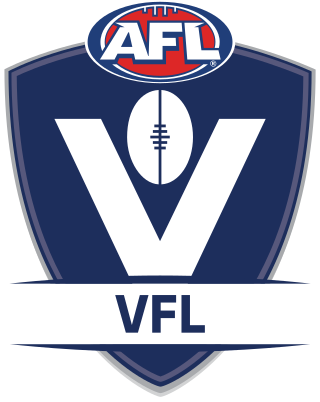
The Victorian Football League (VFL) is an Australian rules football competition in Australia operated by the Australian Football League (AFL) as a second-tier, regional, semi-professional competition. It includes teams from clubs based in eastern states of Australia: Victoria, New South Wales and Queensland, including reserves teams for the eastern state AFL clubs. It succeeded and continues the competition of the former Victorian Football Association (VFA) which began in 1877. The name of the competition was changed to the Victorian Football League in 1996. Under its VFL brand, the AFL also operates a women's football competition known as VFL Women's, which was established in 2016.

Alexander Eason was an Australian rules football player, coach and administrator in the Victorian Football League and Victorian Football Association.

Basil Milton McCormack was an Australian rules footballer who played in the Victorian Football League (VFL) between 1925 and 1936 for the Richmond Football Club.

The 1924 VFL season was the 28th season of the Victorian Football League (VFL), the highest-level senior Australian rules football competition in Victoria. The season featured nine clubs and ran from 26 April to 27 September, comprising a 16-match home-and-away season followed by a three-week finals series featuring the top four clubs.
The 1928 VFL season was the 32nd season of the Victorian Football League (VFL), the highest-level senior Australian rules football competition in Victoria. The season featured twelve clubs and ran from 21 April to 29 September, comprising an 18-match home-and-away season followed by a four-week finals series featuring the top four clubs.

The 1942 VFL season was the 46th season of the Victorian Football League (VFL), the highest level senior Australian rules football competition in Victoria.

The 1944 VFL season was the 48th season of the Victorian Football League (VFL), the highest level senior Australian rules football competition in Victoria.
The 1886 Victorian Football Association season was the 10th season of the Australian rules football competition. The premiership was won by the Geelong Football Club. It was the club's seventh VFA premiership, and the last won by its senior team.

The 1897 Victorian Football Association season was the 21st season of the Australian rules football competition. The premiership was won by the Port Melbourne Football Club, the first premiership in its history.
Eric James Edward Fleming was an Australian rules footballer who played for the Geelong Football Club in the Victorian Football League (VFL), and for the Oakleigh Football Club in the Victorian Football Association (VFA).
Frederick Joseph Rutley was an Australian rules footballer who played for North Melbourne in both the Victorian Football Association (VFA) (1922-1924) and the Victorian Football League (VFL).
The Motordrome, also known as the Olympic Park Speedway, the Melbourne Speedway or the Victorian Speedway, was a former speedway and Australian rules football ground located approximately on the site of the present day Melbourne Rectangular Stadium in Olympic Park in Melbourne, Victoria. The ground was primarily a speedway track, but also hosted football matches.

The 1919 Victorian Football Association season was the 41st season of the Australian rules football competition. The season was the first to be played after hostilities ended in World War I, and saw a return to a full-length season featuring all ten clubs for the first time since 1914.

The 1922 Victorian Football Association season was the 44th season of the Australian rules football competition. The premiership was won by the Port Melbourne Football Club, after it defeated Footscray by two points on 23 September, in a controversial Grand Final which several of its players were offered money to throw. It was the club's third VFA premiership.
The 1923 Victorian Football Association season was the 45th season of the Australian rules football competition. The premiership was won by the Footscray Football Club, after it defeated Port Melbourne by 14 points in the Grand Final on 1 October. It was the club's eighth VFA premiership, which meant that the club surpassed Geelong (L.) for the most premierships won in VFA history.
The 1924 Victorian Football Association season was the 46th season of the Australian rules football competition. The premiership was won by the Footscray Football Club, after it defeated Williamstown by 45 points in the final on 20 September. It was the club's ninth and last VFA premiership before it, along with North Melbourne and Hawthorn, joined the Victorian Football League the following year; this marked the end of a long period of dominance for Footscray, which had seen it win five minor premierships in a row and four major premierships in six years.
The 1924 match for Dame Nellie Melba's Appeal for Limbless Soldiers, informally known as the 1924 Championship of Victoria, was an Australian rules football exhibition match played on 4 October 1924 between the Essendon Football Club and the Footscray Football Club – who were that season's premiers of the Victorian Football League (VFL) and Victorian Football Association (VFA), respectively. Footscray recorded an upset victory against Essendon by 28 points, giving the VFA one of its most significant victories, on-field or off-field, against its stronger-rival competition. The match raised £2,800 for the fund.
The 1925 Victorian Football Association season was the 47th season of the Australian rules football competition. The premiership was won by the Brunswick Football Club, after it defeated Port Melbourne by 16 points in the final on 31 August. It was the club's second VFA premiership.
The 1926 Victorian Football Association season was the 48th season of the Australian rules football competition. The premiership was won by the Coburg Football Club, after it defeated Brighton by 16 points in the final on 18 September. It was the club's first VFA premiership, achieved in only its second season of senior competition.









